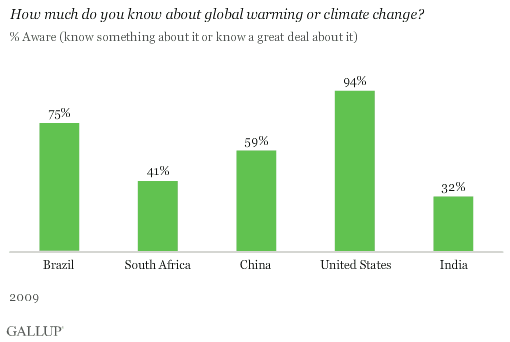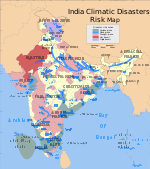Gallup report: http://www.gallup.com/poll/125267/indians-largely-unaware-climate-change.aspx
JGCRI researchers Antoinette Brenkert and Elizabeth Malone assessed the vulnerability of India and Indian states to climate change using the Vulnerability-Resilience Indicator Model (VRIM). The model was adapted from the global/country version to account for Indian dietary practices and data availability with regard to freshwater resources. Results (scaled to world values) show nine Indian states to be moderately resilient to climate change, principally because of low sulfur emissions and a relatively large percentage of unmanaged land. Six states are more vulnerable than India as a whole, attributable largely to sensitivity to sea storm surges. Analyses of results at the state level (Orissa, and comparisons between Maharashtra and Kerala, and Andhra Pradesh and Himachal Pradesh) demonstrate the value of VRIM analyses used in conjunction with other socioeconomic information to address initial questions about the sources of vulnerability in particular places. The modeling framework allows analysts and stakeholders to systematically evaluate individual and sets of indicators and to indicate where the likely vulnerabilities are in the area being assessed.
http://www.globalchange.umd.edu/featured-research/assessing-vulnerability-in-india-and-indian-states/
Vulnerability-Resilience Indicator Model (VRIM).
Moss RH, Brenkert AL, Malone EL. Vulnerability to Climate Change: A Quantitative Approach. 2001;
PNNL-SA-33642, Pacific Northwest National Laboratory, Washington, DC.
suggested
The Vulnerability-Resilience Indicators Model (VRIM) (Moss et al. 2001, Brenkert and Malone 2005)
identifies 17 factors (listed in the table below) that together assess the vulnerability of a society. Managed
and unmanaged land, economic activities that are natural-resource-intensive, and socioeconomic
characteristics are represented.
Model: http://www.cmts.gov/downloads/VRIM%20description.pdf
Climate change in the coastal borders of India is erratic. Climate-related natural disasters cause massive losses of Indian life and property. Droughts, flash floods, cyclones, avalanches, landslides brought on by torrential rains, and snowstorms pose the greatest threats. Other dangers include frequent summer dust storms, which usually track from north to south; they cause extensive property damage in North India and deposit large amounts of dust from arid regions. Hail is also common in parts of India, causing severe damage to standing crops such as rice and wheat.
SECTORAL
INDICATORS
PROXY VARIABLES PROXY FOR
Food security Cereals production/ crop
land area
Degree of modernization in the a




